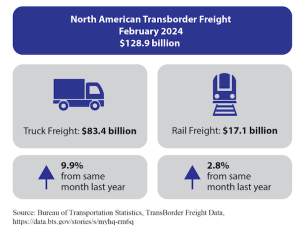The Port of Prince Rupert officially opened its first container terminal September 12, and with it a new route for double stack container trains between Canada's West Coast and US Midwest cities including Chicago, Illinois, and Memphis, Tennessee. Speaking to a crowd of over 600 invited guests, Don Krusel, president and CEO, applauded the three levels of government for their financial support, the Ts'msyen First Nations, Maher Terminals, Canadian National Railway and China Ocean Shipping (Canada) Inc. which will be the first shipping line to offload containers at the port. The C$170 million facility with three super post Panamax cranes and a design capacity of 500,000 teus was constructed, "On time and on budget," Krusel said. Prince Rupert is an uncongested, deepwater port located closer to Asia than any other North American port. It is served by Canadian National Railway.
James Foote, executive vice-president, sales and marketing, said Canadian National Railway has upgraded rail traffic control systems, extended sidings and purchased 50 locomotives to increase the capacity of the rail corridor between the Port of Prince Rupert and Memphis, Tennessee.
The real test of the new container terminal and its equipment, however, will come when a COSCO vessel arrives at the terminal in October. In May of this year Brian Maher, Chairman and Chief Executive of Maher Terminals, announced that an agreement had been reached with COSCO to visit the terminal on a weekly basis. "Maher Terminals has a long and valued relationship with COSCO," Don McBeth, Executive Vice President, Sales and Marketing with Maher Terminals LLC said. "We are pleased that COSCO has seized the opportunity to provide to its customers the benefit of the added transportation capacity that the Prince Rupert trade corridor will make available.
Chase Zhang, Executive Vice President of COSCO Container Lines Americas, Inc., told AJOT at the opening that the decision to be the first container line to stop at Prince Rupert on a regular basis was a year and a half in the making. Part of the decision, he said, resulted from company's concerns about the possible impact of next year's labor negotiations with roughly 10,000 US West Coast Longshoremen belonging to the ILWU, including the Port of Long Beach. Prince Rupert, he said, was looked at as a possible contingency plan. However, as discussions progressed with the port and other stakeholders, the company became increasingly interested in being the first container line to use the new terminal.
"We could see that this project could provide ' tremendous advantage for the container supply chain into America," he said.
"This provides us with shorter transit times on the seaway and, also CN, our partners on the railroad, has provided us with shorter transit times on the lane. So that's the advantage we can deliver to our customers," he said.
Zhang said COSCO is confident the new terminal will succeed.
"We're trying something new and something different," he said. Plans are for COSCO to bring a 5,400-teu container ship into the port on a weekly basis. The majority of the cargo, Zhang said, will be destined to the US Midwest, with a portion delivered into Eastern Canada.
Zhang also pointed out that COSCO has had previous experience shipping containers into the US Midwest through the Port of Vancouver.
As for other ports in the northwest, Zhang said the company has a weekly service into Seattle and that Tacoma is part of COSCO's "long term strategies."
Zhang told the audience of federal, provincial and municipal officials, an Asian delegation, equipment suppliers and project consultants, businessmen and potential shippers that Fairview Terminal will bring a tremendous economic advantage to Prince Rupert.
"The cargoes that will now flow between Asia and North America through this scenic and well designed port will boost the effectiveness of ocean carriers such as COSCO," he said "while, at the same time, offering further economic deve







